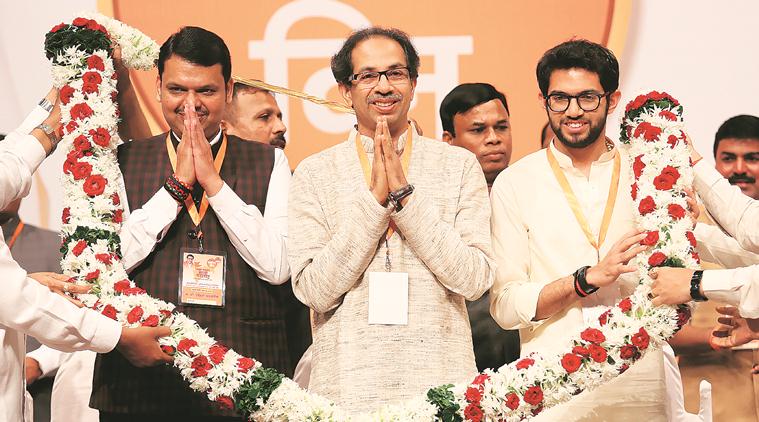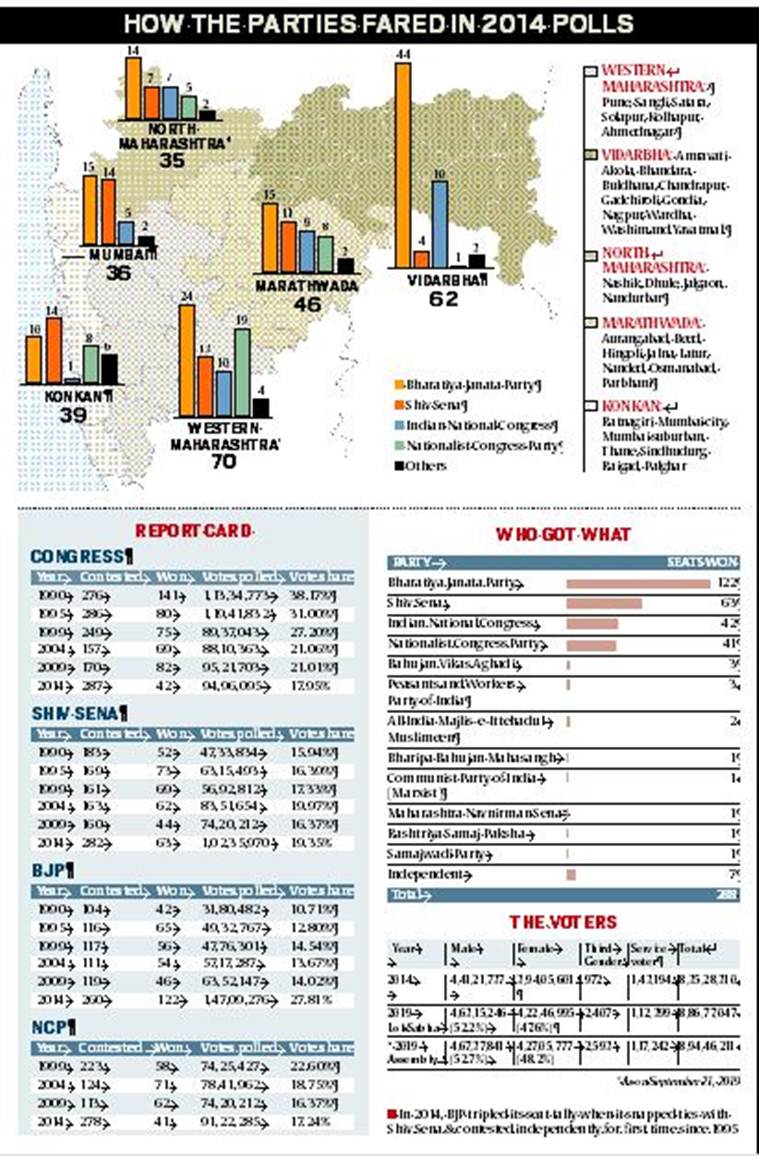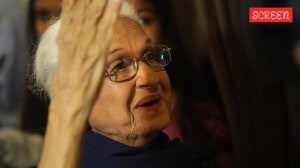Stay updated with the latest - Click here to follow us on Instagram
Maharashtra: BJP & Shiv Sena to battle it out for supremacy, Opposition for survival
Since 2014, when the BJP emerged as the most powerful political force in the state for the first time, tension has been simmering between the two sides.
 The landslide victory in the 2019 Lok Sabha polls, where the BJP-Sena alliance, under Prime Minister Narendra Modi’s leadership, won 41 of the 48 seats in the state, has bolstered BJP’s hope for a bigger mandate this time. (Source: File)
The landslide victory in the 2019 Lok Sabha polls, where the BJP-Sena alliance, under Prime Minister Narendra Modi’s leadership, won 41 of the 48 seats in the state, has bolstered BJP’s hope for a bigger mandate this time. (Source: File)
THE ASSEMBLY elections on October 21 is set to be a test for the uneasy alliance between the BJP and the Shiv Sena. With the Opposition still in disarray after the Lok Sabha poll drubbing and weakened even more due to desertions of several leaders in the run-up to the state polls, many political analysts believe that the October polls will be a battle of supremacy between the two ruling allies.
Since 2014, when the BJP emerged as the most powerful political force in the state for the first time, tension has been simmering between the two sides. So, even as both parties have firmed up a pre-poll alliance, BJP’s poll strategy is to get as close to the half-way mark of 144 seats on its own.
Five years ago, BJP, riding on the Narendra Modi wave, had tripled its seat tally (46 seats in 2009 to 122 seats in 2014) when the two parties had snapped ties and contested independently for the first time since 1995. It has since notched up crucial wins in local body polls and made key acquisitions from the Opposition ranks to enhance its own footprint in Maharashtra.
Further, the landslide victory in the 2019 Lok Sabha polls, where the BJP-Sena alliance, under Prime Minister Narendra Modi’s leadership, won 41 of the 48 seats in the state, has bolstered BJP’s hope for a bigger mandate this time.

Its current political heft can be gauged from the rising eagerness of former ministers and legislators from the Opposition to join its ranks. Setting the ball rolling, the PM, while addressing a party rally in Nashik on September 19, sought a “clear majority” for the BJP under Devendra Fadnavis’ leadership in the state.
The Uddhav Thackeray-led Shiv Sena, once the more dominant force in the saffron alliance in Maharashtra, has been forced to play second fiddle to the BJP since its upswing in 2014. Sena’s strategists know that if the BJP manages to further improve its tally in the state Legislative Assembly and reach anywhere near the half-way mark, its own position in the alliance will be compromised further.
This, said party sources, was one of the key reasons behind Uddhav’s initial insistence of equal sharing of seats and power in the state. But seized of the importance of staying in the alliance, the Sena has, however, ceded some ground. Although the official seat-sharing arrangement is yet be announced, Sena is likely to contest 126 seats, while BJP (alongwith smaller allies) will contest the remaining 162, said sources.
To match the BJP in this power tussle, even the Sena, over the last few months, has systematically inducted Opposition turncoats, including some sitting legislators on seats that the BJP has traditionally contested in the alliance. To retain its own relevance, it has also projected party’s heir apparent, Aaditya Thackeray, as a chief ministerial face — a move that has seen some resistance from the BJP camp.
Fadnavis, who is seeking a second consecutive term, has labelled himself as the face of the alliance and embarked on a statewide tour, having become only the second CM after Vasantrao Naik to complete a full term.
But this battle of supremacy between the saffron allies has come at the cost of the Opposition, with the two main principal parties, the Congress and the NCP, fighting for survival in a state they once dominated.
In 2014, the Congress had won just 42 seats and the NCP 41. The loss in local body elections held thereafter eroded both the parties even further. So much so that in the 2019 Lok Sabha polls, the Opposition had trailed in even 39 of the 83 Assembly segments controlled by the two parties.
Key desertions in the run-up to the state polls have hit their election prospects further. Consider this. Since the Lok Sabha polls, 24 senior leaders — including 13 serving legislators and 10 former ministers — have switched over to either the BJP or the Sena. The BJP, in particular, has been making concerted efforts to weaken NCP’s support base in western Maharashtra, from where Sharad Pawar’s party draws the most clout.
The elections will also be a test of Pawar’s political acumen. With the Congress lacking a strong mass leader and battling infighting, the onus of leading the Opposition’s campaign has fallen on the NCP’s patriarch yet again. But Pawar’s own party has been hit the most by the ongoing exodus, forcing the 78-year-old to embark on a statewide tour to remotivate his cadre. Another poll drubbing could end Pawar’s five-decade-old political career on a sour note.
What’s at stake
BJP
IN SPITE of announcing an alliance with the Shiv Sena, the underlying sentiment within the BJP is the push to attain electoral majority in the state Assembly on its own. Maharashtra, the economic capital of India and a leading industrial state, is crucial for the party. To emerge in a commanding position, it feels that absolute majority would make it less dependent on alliances when it comes to driving policies and reforms in core sectors.
Another crucial factor is to strike a perfect balance between the old guard and outsiders who have joined the organisation ahead of polls. Chief Minister Devendra Fadnavis, who is prepping himself for a second term in office will, however, have to walk a tightrope in addressing growing in-house aspirations and unrest.
SHIV SENA
The entire strategy of the Shiv Sena for the elections is to work towards installing a Thackeray at the seat of power. Since its founding in the 1960s, no Thackeray family member has ever made a foray into electoral politics. The elections point to a fundamental shift in the Sena’s political thinking, which insulated the Thackeray clan from playing a hands on role in running the government. The Thackerays want to install Aaditya as a prospective candidate to run the next government. The strategy is aimed to ensuring that it remains within touching distance of the BJP’s seat tally, which will give it more leverage to strike an equitable power-sharing agreement.
NCP
In its 30-year-old existence, the NCP is set to fight its toughest political battle yet after facing numerous defections by senior leaders over the last two months. The Assembly elections will be a major political test of NCP founder Sharad Pawar’s tactical acumen, as he has himself hit the ground to plan the revival of his party. At the age of 78, Pawar is seen as the binding factor that is holding the NCP together and a beating at the hustings could end his five-decade-old political career.
CONGRESS
For the Congress, the state polls will be a test of its survival. Riddled with factionalism and lacking a strong state leadership, it had recorded its worst-ever Lok Sabha poll performance earlier this year, winning just one seat in the state. Mass exodus of key leaders from its ranks has also hit the party’s election preparations, which has demoralised its cadre even further going into the polls. The elections will also test the mettle of newly-appointed state Congress president Vijay (Balasaheb) Thorat. While the elections couldn’t have come at a more opportune time for Congress with the economic downturn, job loss and Maharashtra’s rural economy faltering due to natural vagaries, the big question is where it can capitalise on these. Most say unlikely.







